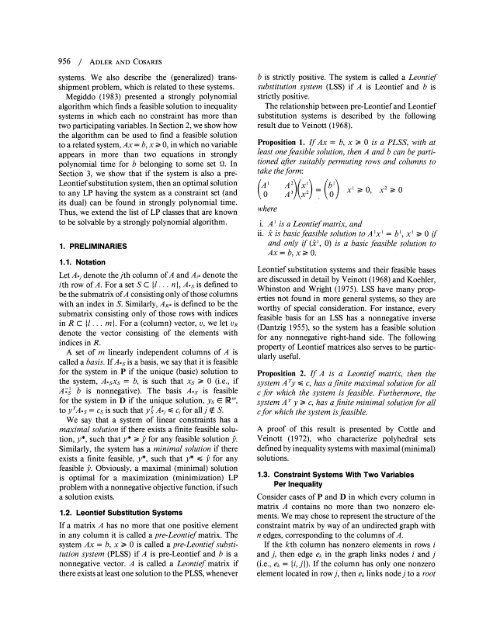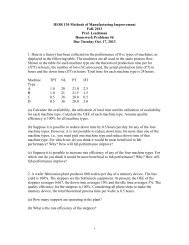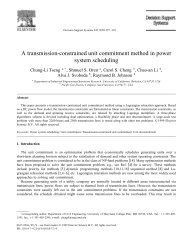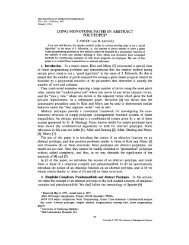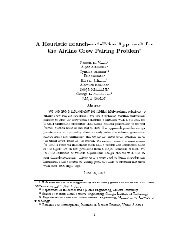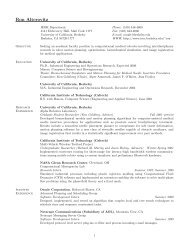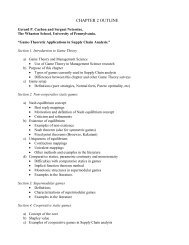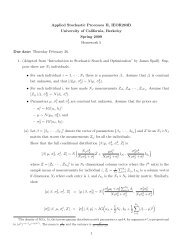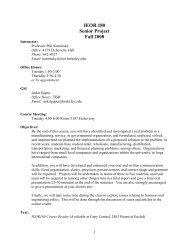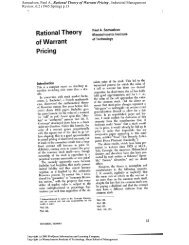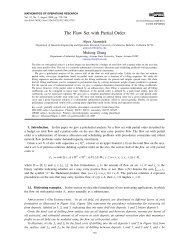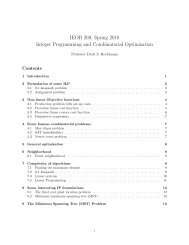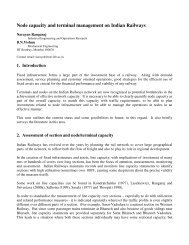a strongly polynomial algorithm for a special class of linear programs
a strongly polynomial algorithm for a special class of linear programs
a strongly polynomial algorithm for a special class of linear programs
You also want an ePaper? Increase the reach of your titles
YUMPU automatically turns print PDFs into web optimized ePapers that Google loves.
956 / ADLER AND COSARES<br />
systems. We also describe the (generalized) transshipment<br />
problem, which is related to these systems.<br />
Megiddo (1983) presented a <strong>strongly</strong> <strong>polynomial</strong><br />
<strong>algorithm</strong> which finds a feasible solution to inequality<br />
systems in which each no constraint has more than<br />
two participating variables. In Section 2, we show how<br />
the <strong>algorithm</strong> can be used to find a feasible solution<br />
to a related system, Ax = b, x : 0, in which no variable<br />
appears in more than two equations in <strong>strongly</strong><br />
<strong>polynomial</strong> time <strong>for</strong> b belonging to some set Q. In<br />
Section 3, we show that if the system is also a pre-<br />
Leontief substitution system, then an optimal solution<br />
to any LP having the system as a constraint set (and<br />
its dual) can be found in <strong>strongly</strong> <strong>polynomial</strong> time.<br />
Thus, we extend the list <strong>of</strong> LP <strong>class</strong>es that are known<br />
to be solvable by a <strong>strongly</strong> <strong>polynomial</strong> <strong>algorithm</strong>.<br />
1. PRELIMINARIES<br />
1.1. Notation<br />
Let A.. denote the jth column <strong>of</strong> A and Ai* denote the<br />
ith row <strong>of</strong> A. For a set S C {1... n , A*s is defined to<br />
be the submatrix <strong>of</strong> A consisting only <strong>of</strong> those columns<br />
with an index in S. Similarly, AR* is defined to be the<br />
submatrix consisting only <strong>of</strong> those rows with indices<br />
in R C {1. . . m[. For a (column) vector, v, we let VR<br />
denote the vector consisting <strong>of</strong> the elements with<br />
indices in R.<br />
A set <strong>of</strong> m <strong>linear</strong>ly independent columns <strong>of</strong> A is<br />
called a basis. If A*S is a basis, we say that it is feasible<br />
<strong>for</strong> the system in P if the unique (basic) solution to<br />
the system, A*SxS = b, is such that xs 2 0 (i.e., if<br />
A*S b is nonnegative). The basis A*s is feasible<br />
<strong>for</strong> the system in D if the unique solution, ys E R'm,<br />
to YTA*s = cs is such that ys A*j < cj <strong>for</strong> all j 4 S.<br />
We say that a system <strong>of</strong> <strong>linear</strong> constraints has a<br />
maximal solution if there exists a finite feasible solution,<br />
y*, such that y* : ' <strong>for</strong> any feasible solution D.<br />
Similarly, the system has a minimal solution if there<br />
exists a finite feasible, y*, such that y* < ' <strong>for</strong> any<br />
feasible j. Obviously, a maximal (minimal) solution<br />
is optimal <strong>for</strong> a maximization (minimization) LP<br />
problem with a nonnegative objective function, if such<br />
a solution exists.<br />
1.2. Leontief Substitution Systems<br />
If a matrix A has no more that one positive element<br />
in any column it is called a pre-Leontief matrix. The<br />
system Ax = b, x 2 0 is called a pre-Leontief substitution<br />
system (PLSS) if A is pre-Leontief and b is a<br />
nonnegative vector. A is called a Leontief matrix if<br />
there exists at least one solution to the PLSS, whenever<br />
b is strictly positive. The system is called a Leontief<br />
substitution system (LSS) if A is Leontief and b is<br />
strictly positive.<br />
The relationship between pre-Leontief and Leontief<br />
substitution systems is described by the following<br />
result due to Veinott (1968).<br />
Proposition 1. If Ax = b, x , 0 is a PLSS, with at<br />
least one feasible solution, then A and b can be partitioned<br />
after suitably permuting rows and columns to<br />
take the <strong>for</strong>m:<br />
(<br />
A 3A)(i )7 I(b _) xl , X2 _ 0<br />
where<br />
i. A' is a Leontief matrix, and<br />
ii. x is basic feasible solution to A 'x' = b', xl I 0 if<br />
and only if (xl, 0) is a basic feasible solution to<br />
Ax = b, x : 0.<br />
Leontief substitution systems and their feasible bases<br />
are discussed in detail by Veinott (1968) and Koehler,<br />
Whinston and Wright (1975). LSS have many properties<br />
not found in more general systems, so they are<br />
worthy <strong>of</strong> <strong>special</strong> consideration. For instance, every<br />
feasible basis <strong>for</strong> an LSS has a nonnegative inverse<br />
(Dantzig 1955), so the system has a feasible solution<br />
<strong>for</strong> any nonnegative right-hand side. The following<br />
property <strong>of</strong> Leontief matrices also serves to be particularly<br />
useful.<br />
Proposition 2. If A is a Leontief matrix, then the<br />
system A Ty < c, has a finite maximal solution <strong>for</strong> all<br />
c <strong>for</strong> which the system is feasible. Furthermore, the<br />
system A T y : c, has a finite minimal solution <strong>for</strong> all<br />
c<strong>for</strong> which the system is feasible.<br />
A pro<strong>of</strong> <strong>of</strong> this result is presented by Cottle and<br />
Veinott (1972), who characterize polyhedral sets<br />
defined by inequality systems with maximal (minimal)<br />
solutions.<br />
1.3. Constraint Systems With Two Variables<br />
Per Inequality<br />
Consider cases <strong>of</strong> P and D in which every column in<br />
matrix A contains no more than two nonzero elements.<br />
We may chose to representhe structure <strong>of</strong> the<br />
constraint matrix by way <strong>of</strong> an undirected graph with<br />
n edges, corresponding to the columns <strong>of</strong> A.<br />
If the kth column has nonzero elements in rows i<br />
and j, then edge ek in the graph links nodes i and j<br />
(i.e., ek = {i, j4). If the column has only one nonzero<br />
element located in row j, then ek links node j to a root


